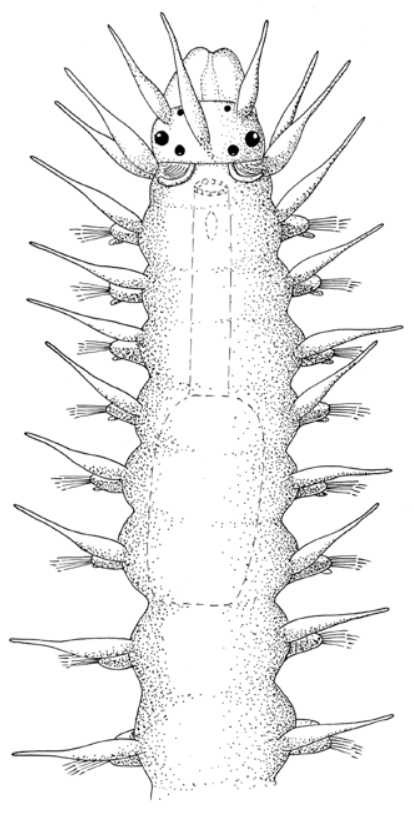Salvatoria clavata
Salvatoria clavata
Salvatoria clavata is a small syllid recognizable when alive by the white spot on the dorsum. It is common in shallow hard bottoms below 1 m depth, among algae and seaweed and also among shell gravel.
- Innhold
- Measurements
- Characteristics
- Look-alikes
- Biology, ecology and behaviour
- Habitat
- Recommended citation
Measurements
Salvatoria clavata
Length up to 0.3 cm and with up to just over 30 segments.
Characteristics
Salvatoria clavata is a rather small semi-transparent species with a white pigment spot on the dorsal posterior end, only visible in live material, not when specimens have been fixed. The palps are about as long as the head and they are fused with a membrane. The head has four orange eyes and two small eye spots in the front. First chaetiger has two pairs of tentacular cirri. The dorsal cirri are about as long as the body width. The blades of the composite chaetae vary in length.
Look-alikes
The small syllids require some experience to identify to species level. Some of the features used for identification require compound microscopes and good literature to be able to compare similarly looking species. Salvatoria clavata resembles other members of the subfamily Exogoninae, but Salvatoria is recognized by having two pairs of tentacular cirri instead of one pair like Sphaerosyllis species, and all appendages are slender and fusiform instead of short and bottle-shaped, like the ones in Brania species. When alive, the species are easily recognizable by the white spot on the posterior end.
Biology, ecology and behaviour
Females carry eggs and larvae on the dorsum, four per segment, from segment 9 through segment 27.
Habitat
Salvatoria clavata is common on shallow hard bottoms below 1 m depth, among algae and seaweed and also among shell gravel. The species is reported from almost all over the world, but it is likely that this actually is a complex of similarly looking species.
Recommended citation
Capa M. Salvatoria clavata (Claparède, 1863). www.artsdatabanken.no/Pages/313093. Downloaded <year-month-day>.

